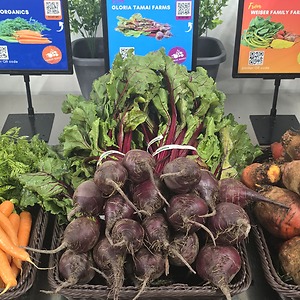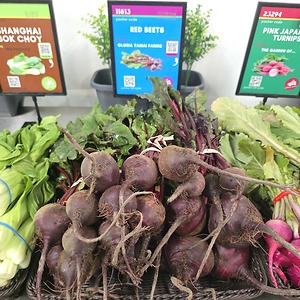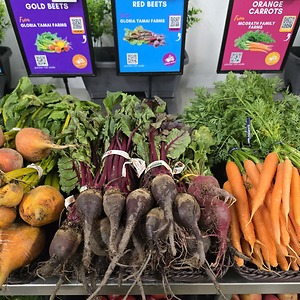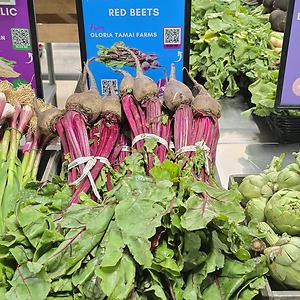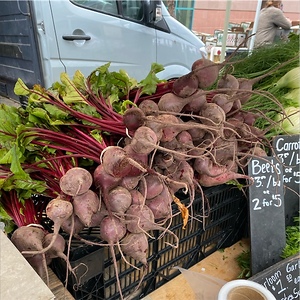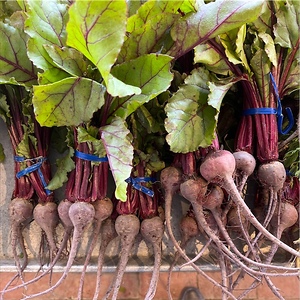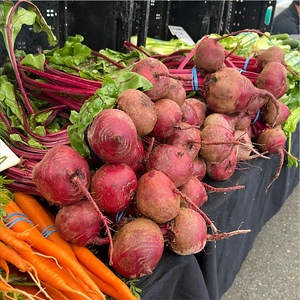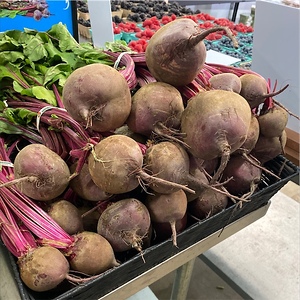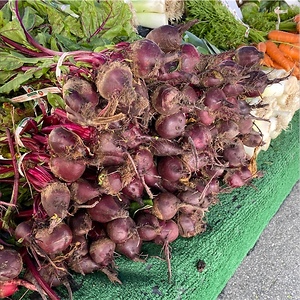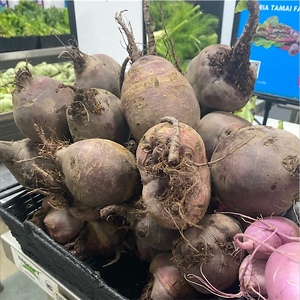


Baby Red Beets
Estimated Inventory, 24 ct : 7.92
This item was last sold on : 03/31/25
Description/Taste
Baby Red beets are harvested young for their edible roots, stems, and leaves. The globular to ovate root has semi-rough, burgundy skin and is connected to thick, crunchy red stems with variegated green and red leaves that range 25-30 centimeters in length. Underneath the thin skin, the flesh is firm, maroon, and crisp. Baby Red beets have a very sweet, earthy flavor and when cooked, they develop a tender, soft texture.
Seasons/Availability
Baby Red beets are available year-round.
Current Facts
Baby Red beets, botanically classified as Beta vulgaris, are edible, underground roots that sprout tall leaves and are members of the Amaranthaceae family. Many different varieties can be sold under Baby Red beets, as the name is a general descriptor used for red beets that are harvested at an immature state. Since the late 19th century, Detroit red beets have remained one of the most popular heirloom varieties, highly regarded for its color and flavor, and are often sold in its baby form as a specialty variety. Baby Red beets are cultivated primarily as a table root, used in everyday cooking in both sweet and savory preparations.
Nutritional Value
Baby Red beets contain manganese, iron, vitamins C and B6, magnesium, potassium, folate, and phosphorus.
Applications
Baby Red beets are popularly consumed raw in salads and in cooked applications such as roasting, steaming, frying, and boiling. It is important to note that Baby Red beets will bleed a dark red hue when raw or cooked, and this liquid has the potential to stain surfaces and skin. The roots can be roasted whole to develop a caramelized consistency, steamed to create a soft, tender flesh, or sliced thinly into wedges and fried into chips. The advantage of cooking with Baby Red beets is that they require less cooking time than the mature roots and the skin can be easily removed after cooking. The roots can also be blended into hummus, chopped finely into veggie burgers, or juiced for a healthy beverage. In addition to cooking, Baby Red beets can be preserved via pickling which changes their flavor profile and extends the length of the root's shelf-life. The leaves are also edible, commonly sautéed or used in salads, and are prized for their tender, crisp texture. Baby Red beets pair well with cheeses such as pecorino and gorgonzola, fruits such as oranges, apples, and pears, mint, anise, caraway seeds, ginger, fennel, and balsamic. The roots will keep up to two weeks with the leaves removed when stored in the crisper drawer of the refrigerator and up to one week when stored with the tops still attached.
Ethnic/Cultural Info
In the United States, chefs and food bloggers are encouraging a new image of the red beet in hopes of raising awareness of its nutritional value and versatility in culinary applications. No longer an out-of-date root associated with its polarizing earthy flavor, Baby Red beets are being promoted as a specialty variety that is mild, sweet, and tender. These small beets are earning the title of a superfood due to their high antioxidant content and are being used in trendy health food recipes as a secret ingredient in cakes, brownies, muffins, fruit juices, and smoothies. Many bloggers on social media platforms are even promoting that beet juice can help reduce garlic breath. Baby Red beets are also praised among the zero-waste movement as the entire plant is edible including the roots, stems, and leaves.
Geography/History
Red beets are native to the Mediterranean and Atlantic coasts of Europe and North Africa and have been growing wild since ancient times. Initially, the plant was cultivated for its leafy green tops, and the roots were often discarded or used as animal feed. Consumption of the root itself did not take place until the 1800s, and the discovery of the beet's high sugar content also led to its increased agricultural value, spreading the root throughout the world via immigration and trade. Today Baby Red beets can be found at specialty grocers and farmers markets in Europe, Asia, Australia, and the Americas.
Featured Restaurants
Restaurants currently purchasing this product as an ingredient for their menu.
| Lodge at Torrey Pines Grill | San Diego CA | 858-453-4420 |
| Lodge at Torrey Pines Main | San Diego CA | 858-453-4420 |
| KI's | Encinitas CA | 760-586-8289 |
| Inn at Rancho Santa Fe (Banquet) | Rancho Santa Fe CA | 858-381-8289 |
| Georges at the Cove | San Diego CA | 858-454-4244 |
| Rancho Valencia | Del Mar CA | 858-756-1123 |
| Coast Catering | Escondido CA | 619-295-3173 |
| Estancia Adobe | San Diego CA | 858-550-1000 |
| Cody's La Jolla | La Jolla CA | 858-459-0040 |
| Kitchens For Good | San Diego CA | 619-450-4040 |
| Mille Fleurs | Rancho Santa Fe CA | 858-756-3085 |
| Napatini Bistro & Wine Bar | Carlsbad CA | 415-505-5955 |
| Continental Catering Inc | La Mesa CA | 907-738-9264 |
| Callie | San Diego CA | 619-947-9036 |
| Rustic Root | San Diego CA | 619-232-1747 |
| The Joint | San Diego CA | 619-222-8272 |
| La Jolla Country Club | San Diego CA | 858-454-9601 |
| Tribute Pizza | San Diego CA | 858-220-0030 |
| Olivewood Gardens and Learning Center | National City CA | 619-434-4281 |
| Mister A's | San Diego CA | 619-239-1377 |
| Carte Hotel | San Diego CA | 619-365-1858 |
| Mission Bay Beach Club | San Diego CA | 858-201-7551 |
| The Farm Golf Club | Rancho Santa Fe CA | 858-756-5585 |
| Del Mar Country Club | Rancho Santa Fe CA | 858-759-5995 |
| DS Catering Kitchen | Chula Vista CA | 619-703-9321 |
| Urban Kitchen Catering | San Diego CA | 619-276-8803 |
| Secret Sister | San Diego CA | 619-281-0718 |
| Hotel La Jolla - Sea & Sky | La Jolla CA | 858-459-0261 |
Recipe Ideas
Recipes that include Baby Red Beets. One
Podcasts



